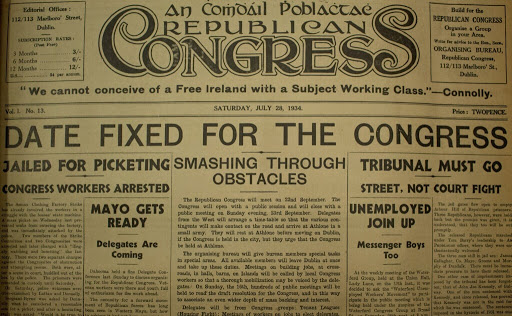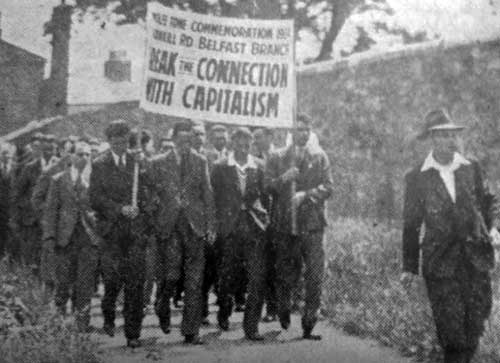March-September 1934.
From the late 1920s, the Irish Republican Army began to move decidedly towards Socialism. In 1931 the IRA Army Council established a new Socialist Republican, over ground Political Organisation, Saor Éire. Saor Éire was to be a rallying point for the workers and small farmers disaffected by the continuing Free State Counter Revolution, to mobilise them in the popular struggle for National Liberation and the Republic. Responding to the threat of organised Socialist Republicans, the Free State banned Saor Éire. There was now a disagreement within the Republican Army about how best to pursue Socialist Republican objectives.
Militant Socialist Republicans within the IRA around Peadar O’Donnell, George Gilmore and Frank Ryan continued to advocate the establishment of an open mass organisation to mobilise the workers and small farmers into the struggle. Others within the Army Council including Moss Twomey, who had supported Saor Éire believed the time was not right for an open front as it would meet the same fate as Saor Éire in 1931.
In 1933 Socialism continued to gain ground within the Republican Army, when the IRA published its avowedly Socialist ‘Government Policy and Constitution for the Republic. Volunteers were also by now engaged in street battles with the emerging Irish Fascist Organisation, the Blueshirts, led by former commissioner of the Free State Police, Eoin O’Duffy. These developments strengthened the Socialist Republican position within the IRA and O’Donnell, Gilmore, Ryan and their supporters again began to push for the creation of a mass organisation, which they described a ‘congress of Republican opinion’.

The issue came to a head at the IRA’s General Army Convention on March 17 1934, held at the Ballet School on Stephen’s Green. O’Donnell spoke on the idea to establish an All Ireland Republican Congress with representation of trade union and small farmers, and political organisations. He was strongly supported by Gilmore and Ryan and the three Socialist Republican leaders won the support of the majority of the IRA rank and file delegates at the convention. The IRA executive and Army Council then stepped in and vetoed the proposal, defeating O’Donnell’s motion by just one vote.
Mick Price, the IRA’s director of Training then tabled a motion that read, ‘We the authorised delegates from all units of the Army in Ireland and Britain, assembled at the General Army Convention of the IRA, redeclare our allegiance to the Republic of Ireland, based upon production and distribution for use and not for profit in which exploitation of the labour of human beings with all its attendant miseries and insecurities shall not be tolerated as shown in the pamphlet “Government Policy and Constitution of Óglaigh na h-Éireann” issued by the supreme authority of Óglaigh na h-Éireann; and We again declare, in reply to the demands of and coercion by the Governments of “Northern Ireland” and the “Irish Free State” that the Republican Army shall not be disbanded until such a time as the Government of the Irish Republic, based on the social and political principles in the Pamphlet referred to, is functioning.’
Price’s motion was quickly rounded on by the IRA Leadership to such an extent that he withdrew it, and the supporters of the Republican Congress withdrew from the Convention on Sunday March 18. They felt however, that having been defeated on such a tight margin by the leadership, that momentum was with them and that they should forge ahead and establish a Republican Congress because the IRA would not risk a split on the matter. Events would demonstrate that they were wrong.
O’Donnell. Gilmore and Ryan now went on a whirlwind tour of the country to win support from IRA units for a Republican Congress to be held in Athlone on April 8, 1934. More than 200 delegates attended the meeting which issued a revolutionary manifesto calling for a United Front of Republican Forces. The Athlone Manifesto stated, ‘We believe that a Republic of a united Ireland will never be achieved except through a struggle which uproots capitalism on its way. We cannot conceive of a Free Ireland with a subject working class, we cannot conceive of a subject Ireland with a free working class. This teaching of Connolly represented the deepest instinct of the oppressed Irish Nation.”
Trade Unionists, Cumann na mBan, the Communist Party, and rank and file members of Fianna Fáil all endorsed the Republican Congress. The IRA leadership condemned the event and Court-martialled and dismissed Volunteers that supported the New Socialist Republican Venture.
The Irish Citizen Army established in 1913 and which O’Donnell had joined in 1919 joined the Republican Congress. Citizen Army veterans such as Seamus McGowan, Roddy Connolly, Nora Connolly and Jack white were all active in the new movement. Those Volunteers that were dismissed from the IRA were recruited to the ICA and began military training again. ICA units were established in Dublin, Cork, Limerick, Kilkenny and Belfast Army had over 300 volunteers.
From its foundation the ICA had permitted women membership on an equal basis to men, and this principle was continued, an ethos that wasn’t shared within the IRA. With the ICA, the Republican Congress engaged in street battles with the Blueshirts and took an active role supporting striking workers, adopting the ICA mantra that ‘Your skill with a rifle is not more important than your patience on the Picket Line’. The Links between the Republican Congress and the Citizen Army were further demonstrated when the Congress adopted an updated blue Starry Plough as its flag, to compliment the Citizen Armies well known Green version.

By May, the new movement had launched a paper “Republican Congress” edited by Frank Ryan and opened a headquarters in Dublin. Branches of the movement were being formed across the country and its members were active in tenant’s disputes, labour strikes, in agitation on behalf of small farmers and in preventing evictions.
800 Congress members and supporters tuned out for the Annual Wolfe Tone Commemoration organised by the IRA in June 1934. The IRA Army Council issued a ban on unsanctioned banners, which the Republican Congress defied. Led by the Irish Citizen Army carrying the Starry Plough, the Congress joined the march and refused to put away their banners, one of which was the now iconic, ‘Break the Connection with Capitalism’ banner carried by protestant Socialist Republicans from the Shankill Road. The IRA then attempted to intervene and prevent Congress and the Citizen Army from marching. Scuffles broke out and the banner carried by the delegation from the Shankill Road was torn in half. According to the historian Brian Hanley, the Communist Party who also took part in the march but separate from the Republican Congress and Citizen Army Bloc, complied with the IRA orders and were left to march unhindered.

Throughout the summer the Congress remained active in mass work and struggles. The congress was involved in land agitation on Achill Island and members were arrested during a raid on a quarry in Bray County Wicklow, where workers were on strike.
The period of March to late August 1934 can be seen as the high point of Congress agitation, and although the organisation continued until 1939, the months ahead, beginning with a delegate meeting in Rathmines in September, marked the beginning of a difficult period for the Congress that it never quite recovered from. That period and the role of the Republican Congress and the Irish Citizen Army in the establishment of the Connolly Column and the fight against Fascism in Spain will be dealt with in future articles.
The Republican Congress represented a reassertion of the Revolutionary Line of James Connolly and the ethos of the Citizen Army to hold on to its rifles and continue to Fight for the All Ireland People’s Republic, proclaimed in 1916.

